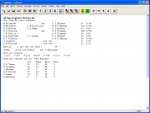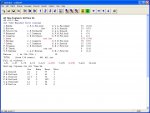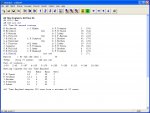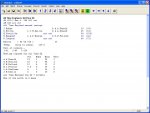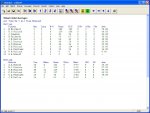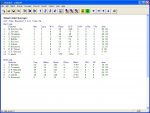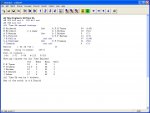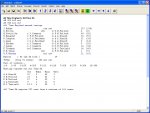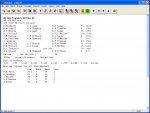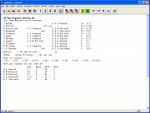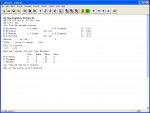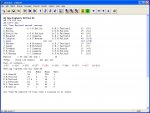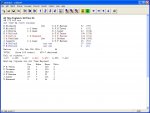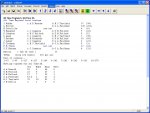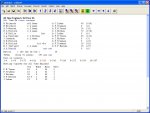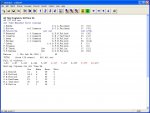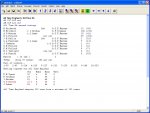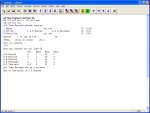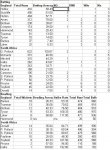-
Welcome to the Cricket Web forums, one of the biggest forums in the world dedicated to cricket.
You are currently viewing our boards as a guest which gives you limited access to view most discussions and access our other features. By joining our free community you will have access to post topics, respond to polls, upload content and access many other special features. Registration is fast, simple and absolutely free so please, join the Cricket Web community today!
If you have any problems with the registration process or your account login, please contact us.
Fantasy Cricket thread
- Thread starter Matt79
- Start date
The Sean
Cricketer Of The Year
We have to be careful that we don't skew this England team wildly in favour of pure stats as we seem to be doing - we're playing three openers instead of two to get higher batting averages in, and we're including two guys with sub-20 bowling averages, one of whom played before WWI and the other who played only a handful of Tests.
Matt79
Hall of Fame Member
Sean's reservations notwithstanding  , here's the first match report - the scorecards and averages are attached as images.
, here's the first match report - the scorecards and averages are attached as images.
-----------------------------------------------
The players and officials were greeted by clear skies, and a pleasant, if not overly warm, day, perfect for cricket in front of a packed Lords ground. South African captain Graeme Pollock gained the early advantage over his English counterpart Len Hutton when he correctly called heads and he had no hesitation in deciding to have a bat on what looked to be a very good batting strip. The pitch had been well prepared, and while the famous Lords slope would offer some assistance to the accurate seamer, there was scant grass and the conditions seemed unlikely to facilitate much movement through the air.
Barry Richards and Bruce Mitchell were the opening pair for South Africa and they endured an early storm from Tyson and Fiery Fred Trueman – Tyson in particular was searingly fast and almost unplayable. However, he also bowled without luck, with a few chances going down and both batsmen also playing and missing several times. Richards in particular was pinned down and found it very difficult to score in his accustomed free manner. To their credit he and Mitchell weathered the early storm and put on a 169 run opening stand before Richards, with the tea break looming was trapped lbw by Botham. Straight after the tea break Botham struck again, removing Nourse. This brought the South African captain to the crease and he and Mitchell remained undefeated at stumps on the first day.
The first session of the second day brought no joy for the English as they toiled without reward – restricting the scoring without breaking through. Mitchell finally completed his century just before lunch, and his concentration lapsed soon after the second session commenced. Pollock continued on towards his ton, while Kallis, Faulkner and Proctor were all content to hang around without attempting to challenge Hutton’s containment tactics. Eventually with the score at 421 for 7, Pollock called a halt to the grind, inserting England with an hour left before stumps on day two. It was a brave decision as 421 seemed an insufficient total to place SA in the box seat, but probably a necessary one if they were to have time to bowl the English out twice on this lifeless pitch. For the English, Trueman and Barnes each picked up a pair of wickets, while Botham snared three. Tyson toiled manfully but without luck, sending down 31 overs for only 54 runs, but no wickets.
Initially it looked like Pollock had timed the declaration right, as while the English openers survived the period before stumps, Donald had the English captain lbw in the second over the third day’s play. This triggered a minor collapse amongst the English, with Donald also dismissing Sutcliffe in his next over thanks to a sharp catch by Barry Richards. The real problems for the English started soon after when in his first over of a new spell Peter Pollock, using the slope to assist his movement had both Hammond and Compton edging to be caught behind the wicket. At that point England were 4-74 and SA looked to be in the box seat. Cometh the hour, cometh the man however, and Les Ames strode to the wicket with a steely look of determination. Together with Hobbs, Ames set about righting the English ship – a job half completed when he lost Hobbs, who adjusted too slowly to a Faulkner wrong-un and gave his first chance, at 5-122. This brough Botham to the crease, and after two and a half days of attritional warfare, it was a Beefy blitzkrieg that brought the home crowd alive. Botham was at his dashing best as he scored at a brisk rate to quickly put England back on an even footing – taking particular toll on Faulkner’s spin. He piled on 70 runs off only 97 deliveries and when he was out after top-edging an attempted hook from Shaun Pollock he was given a standing ovation by the Lords faithful. Laker came and went, but in Trueman, Ames found another sound partner as he pushed past the century mark and on towards a big score. Trueman looked more and more accomplished as he moved from defence towards some adventurous hitting of his own before Mike Proctor had him snicking. With the batting in the pavilion getting thin, Ames hit out, taking his score to an undefeated 175 before running out of partners, and the English score to 441 – a masterful salvage job from the English keeper which has justified his inclusion ahead of Alan Knott. When Barnes fell, halfway through the first session of the fourth day the match evenly poised with the best part of two days to play, although a draw seemed the most likely result.
In reply the South Africans set out after quick runs, but didn’t quite succeed in their intention. Many of the African batsmen got starts, but with some tight disciplined bowling from the English pace battery and some canny field placements by Hutton they were again not able to score at the rate they would have liked. Mitchell, Nourse and G. Pollock were all out trying to increase the scoring tempo and in the end, the South Africans were 9-248 at stumps, Kallis top scoring on 42. Peter Pollock and Alan Donald had the unenviable job of trying to hold off the English long enough to prevent their team going down 1-nil down in the series. Unfortunately they were unable to add to the overnight score before Trueman had Pollock caught. Botham took another three wickets to continue his excellent all-round match.
With almost a full day left to play 229 runs never looked like being enough to trouble the English batting, and although Donald briefly raised SA spirits when he removed first Hobbs, and then right before lunch, Hutton, Denis Compton and Sutcliffe safely guided the English home on a now lifeless wicket to a seven wicket victory. The man of the match award was given to Ames for his masterful salvage job in the English first innings – one of the great innings seen at the venerable old ground, although Botham’s six wickets and sparkling 70 runs was almost as telling a contribution. For the South Africans, the task they face is to find a way to break the English shackles and score quicker runs if they are to bounce back from this early set back.
 , here's the first match report - the scorecards and averages are attached as images.
, here's the first match report - the scorecards and averages are attached as images.-----------------------------------------------
The players and officials were greeted by clear skies, and a pleasant, if not overly warm, day, perfect for cricket in front of a packed Lords ground. South African captain Graeme Pollock gained the early advantage over his English counterpart Len Hutton when he correctly called heads and he had no hesitation in deciding to have a bat on what looked to be a very good batting strip. The pitch had been well prepared, and while the famous Lords slope would offer some assistance to the accurate seamer, there was scant grass and the conditions seemed unlikely to facilitate much movement through the air.
Barry Richards and Bruce Mitchell were the opening pair for South Africa and they endured an early storm from Tyson and Fiery Fred Trueman – Tyson in particular was searingly fast and almost unplayable. However, he also bowled without luck, with a few chances going down and both batsmen also playing and missing several times. Richards in particular was pinned down and found it very difficult to score in his accustomed free manner. To their credit he and Mitchell weathered the early storm and put on a 169 run opening stand before Richards, with the tea break looming was trapped lbw by Botham. Straight after the tea break Botham struck again, removing Nourse. This brought the South African captain to the crease and he and Mitchell remained undefeated at stumps on the first day.
The first session of the second day brought no joy for the English as they toiled without reward – restricting the scoring without breaking through. Mitchell finally completed his century just before lunch, and his concentration lapsed soon after the second session commenced. Pollock continued on towards his ton, while Kallis, Faulkner and Proctor were all content to hang around without attempting to challenge Hutton’s containment tactics. Eventually with the score at 421 for 7, Pollock called a halt to the grind, inserting England with an hour left before stumps on day two. It was a brave decision as 421 seemed an insufficient total to place SA in the box seat, but probably a necessary one if they were to have time to bowl the English out twice on this lifeless pitch. For the English, Trueman and Barnes each picked up a pair of wickets, while Botham snared three. Tyson toiled manfully but without luck, sending down 31 overs for only 54 runs, but no wickets.
Initially it looked like Pollock had timed the declaration right, as while the English openers survived the period before stumps, Donald had the English captain lbw in the second over the third day’s play. This triggered a minor collapse amongst the English, with Donald also dismissing Sutcliffe in his next over thanks to a sharp catch by Barry Richards. The real problems for the English started soon after when in his first over of a new spell Peter Pollock, using the slope to assist his movement had both Hammond and Compton edging to be caught behind the wicket. At that point England were 4-74 and SA looked to be in the box seat. Cometh the hour, cometh the man however, and Les Ames strode to the wicket with a steely look of determination. Together with Hobbs, Ames set about righting the English ship – a job half completed when he lost Hobbs, who adjusted too slowly to a Faulkner wrong-un and gave his first chance, at 5-122. This brough Botham to the crease, and after two and a half days of attritional warfare, it was a Beefy blitzkrieg that brought the home crowd alive. Botham was at his dashing best as he scored at a brisk rate to quickly put England back on an even footing – taking particular toll on Faulkner’s spin. He piled on 70 runs off only 97 deliveries and when he was out after top-edging an attempted hook from Shaun Pollock he was given a standing ovation by the Lords faithful. Laker came and went, but in Trueman, Ames found another sound partner as he pushed past the century mark and on towards a big score. Trueman looked more and more accomplished as he moved from defence towards some adventurous hitting of his own before Mike Proctor had him snicking. With the batting in the pavilion getting thin, Ames hit out, taking his score to an undefeated 175 before running out of partners, and the English score to 441 – a masterful salvage job from the English keeper which has justified his inclusion ahead of Alan Knott. When Barnes fell, halfway through the first session of the fourth day the match evenly poised with the best part of two days to play, although a draw seemed the most likely result.
In reply the South Africans set out after quick runs, but didn’t quite succeed in their intention. Many of the African batsmen got starts, but with some tight disciplined bowling from the English pace battery and some canny field placements by Hutton they were again not able to score at the rate they would have liked. Mitchell, Nourse and G. Pollock were all out trying to increase the scoring tempo and in the end, the South Africans were 9-248 at stumps, Kallis top scoring on 42. Peter Pollock and Alan Donald had the unenviable job of trying to hold off the English long enough to prevent their team going down 1-nil down in the series. Unfortunately they were unable to add to the overnight score before Trueman had Pollock caught. Botham took another three wickets to continue his excellent all-round match.
With almost a full day left to play 229 runs never looked like being enough to trouble the English batting, and although Donald briefly raised SA spirits when he removed first Hobbs, and then right before lunch, Hutton, Denis Compton and Sutcliffe safely guided the English home on a now lifeless wicket to a seven wicket victory. The man of the match award was given to Ames for his masterful salvage job in the English first innings – one of the great innings seen at the venerable old ground, although Botham’s six wickets and sparkling 70 runs was almost as telling a contribution. For the South Africans, the task they face is to find a way to break the English shackles and score quicker runs if they are to bounce back from this early set back.
Attachments
-
82.1 KB Views: 19
-
90.6 KB Views: 16
-
91 KB Views: 14
-
76.5 KB Views: 16
-
86.4 KB Views: 12
-
84.2 KB Views: 11
Last edited:
Magrat Garlick
Rather Mad Witch
SA clearly lacking a decent spinner.
DCC_legend
International Regular
Was thinking of doing a Minnows tour of England. I should really get round to making a squad for it.
Any suggestions anyone?
Any suggestions anyone?
Matt79
Hall of Fame Member
Second Test Match Report - England vs South Africa at Trent Bridge
Pollock won the toss and after a brief hesitation, invited Sir Len to have a bat. The wicket wasn’t overly grassed but nevertheless gave the impression it would be somewhat quicker than the norm and would offer the quicks some assistance early on before settling into a decent strip for batting. Coupled with his declaration in the first test, nobody could accuse Pollock of lacking courage in his captaincy – whether it was bravery that would prove vainglorious remained to be seen.
This decision added further spice to what was shaping as an already interest-filled match. The English press had been incensed in recent days following Pollock’s criticism of what he described as Hutton’s perceived negative tactics – comments that probably reflected the South African’s frustration at their inability to score freely at Lords, and fuelled by his irritation at the criticism of Kallis’ “one-paced batting”. “After Mitchell, Dudley and myself got ourselves out trying to make a game of it, what did they expect Jacques to do?” he had thundered, “make an ass of himself and let our innings collapse merely because we were the only team interested in getting on with it”. The justice of Pollock’s ire remains dubious given that the match did achieve a result – one that went against South Africa, but nevertheless, put an edge on the first morning’s play at Trent Bridge.
Pollock’s decision appeared justified when Donald succeeded in clean bowling Hobbs for just 17 in a ferocious opening burst. However, the captain would have been deflated as Hutton and Sutcliffe and then Hammond guided the home team to past the 200 mark with only two wickets down. In a fit of inspiration or desperation, Pollock threw the ball to Tayfield just before tea, and was rewarded when the spinner had Hammond trapped lbw to leave England at 3-207. Peter Pollock then produced another of what was quickly become his trademark contributions – taking two quick wickets to put the skids on an English innings. This time it was Compton and Ames who fell victim to him, leaving Hutton at the other end and presumably wondering if anyone would stick around with him.
Unfortunately “no” was the answer Len received as Graeme Pollock rotated his seamers at one end with Tayfield persisting at the other. When Donald came back on he tore through the English tail, taking a very fine five wicket haul, including three ducks – to Laker, Trueman and Tyson. With England nine down and only minutes left in the day, Pollock opted for spin at both ends in an effort to squeeze an extra over in, and was rewarded when Faulkner trapped Barnes. The umpires called stumps given the hour, and Pollock would no doubt have been well satisfied with his team’s first day – England all out for 302 – Hutton undefeated on 114*, wondering what had happened since they were 3-207.
Hutton would have been buoyed when early on day 2, Trueman had Mitchell back in the pavilion. However, with the pace attack seeming unthreatening on a pitch that had definitely calmed down since the first morning, Hutton threw the ball to Laker before lunch. It was a ploy that paid off, eventually, with the great off-spinner taking the next three wickets – those of Richards, Nourse and Kallis, as the he enjoyed the bit of turn that had begun to manifest itself surprisingly early combined with an extra bit of bounce. When Barnes chimed in with the wicket of Faulkner, South Africa were rocked halfway through the second session of the day at 5-148. Fortunately for South Africa, they are a team that bats deep, and in Cameron, Shaun Pollock and Tayfield, Pollock found allies to help guide him to his century, and South Africa to a 44 run first innings lead.
Pollock was again buoyed when, early on day three, Shaun Pollock had first innings centurion Hutton trapped leg-before wicket. For a time, it looked like Sutcliffe would post a formidable score, while Hobbs was content to hold up his end without any undue haste towards the scoreboard. However, as he was his knack Peter Pollock again produced a breakthrough when his captain would have been praying for such – having Sutcliffe caught behind for 60. Hammond came to the crease and appeared to energise Hobbs, and together the two greats quickly added another 90-odd runs to the total, before Donald succeeded in drawing a false shot from Hammond. Hobbs continued his rate undaunted for a brief while before Donald struck the double blow of removing first Compton then Ames in quick succession. Hobbs was forced to begin playing conservatively, particularly when Botham was also removed without making double figures – both first test heroes for England, Botham and Ames having dirty games at Trent Bridge. With Laker and Trueman, Hobbs limped the English innings along, in the process passing the 100 mark, until Trueman’s rush of blood and resultant charge down the wicket saw him stumped by Cameron off the bowling of Tayfield. The collapse was complete for England when Barnes made a hash of a call for a quick single and ran Hobbs out. England had scored 300, again a disappointing score given they had been 3-185. The South African target of 257 must have looked awfully small to the English brains trust, especially with nearly two full days remaining to play, but they would have been buoyed by the success the South African quicks had enjoyed in the later half of their innings.
Those hopes would have taken a hit when Barry Richards and Bruce Mitchell started smartly, quickly moving the score along to 66. Ian Botham produced a brief window of hope when he had first Mitchell, then Nourse, back in the pavilion with the score under 75 before lunch. Those hopes would have flowered in cheerfulness when Barnes had a very aggressive Graeme Pollock, who appeared determined to finish the match by tea and make a point about who was playing dull cricket, clean bowled attempting a rather wild stroke for such a good batsman. Jacques Kallis would no doubt have richly enjoyed being the man to guide the South Africans home to a five wicket win just before stumps on day 4, with a measured 67* - produced it must be said, at his own pace, and in which he actually appeared to deliberately slow down in response to some unedifying slow-hand clapping with sprang up in apparent protest at his stately progress.
Allan Donald, having taken 8 wickets and twice sparked collapses by the powerful English line up, each time when they appeared set for a big score, was awarded the honours as man of the match. The series now stands at 1-all, with the next match to be at Headingly.
Pollock won the toss and after a brief hesitation, invited Sir Len to have a bat. The wicket wasn’t overly grassed but nevertheless gave the impression it would be somewhat quicker than the norm and would offer the quicks some assistance early on before settling into a decent strip for batting. Coupled with his declaration in the first test, nobody could accuse Pollock of lacking courage in his captaincy – whether it was bravery that would prove vainglorious remained to be seen.
This decision added further spice to what was shaping as an already interest-filled match. The English press had been incensed in recent days following Pollock’s criticism of what he described as Hutton’s perceived negative tactics – comments that probably reflected the South African’s frustration at their inability to score freely at Lords, and fuelled by his irritation at the criticism of Kallis’ “one-paced batting”. “After Mitchell, Dudley and myself got ourselves out trying to make a game of it, what did they expect Jacques to do?” he had thundered, “make an ass of himself and let our innings collapse merely because we were the only team interested in getting on with it”. The justice of Pollock’s ire remains dubious given that the match did achieve a result – one that went against South Africa, but nevertheless, put an edge on the first morning’s play at Trent Bridge.
Pollock’s decision appeared justified when Donald succeeded in clean bowling Hobbs for just 17 in a ferocious opening burst. However, the captain would have been deflated as Hutton and Sutcliffe and then Hammond guided the home team to past the 200 mark with only two wickets down. In a fit of inspiration or desperation, Pollock threw the ball to Tayfield just before tea, and was rewarded when the spinner had Hammond trapped lbw to leave England at 3-207. Peter Pollock then produced another of what was quickly become his trademark contributions – taking two quick wickets to put the skids on an English innings. This time it was Compton and Ames who fell victim to him, leaving Hutton at the other end and presumably wondering if anyone would stick around with him.
Unfortunately “no” was the answer Len received as Graeme Pollock rotated his seamers at one end with Tayfield persisting at the other. When Donald came back on he tore through the English tail, taking a very fine five wicket haul, including three ducks – to Laker, Trueman and Tyson. With England nine down and only minutes left in the day, Pollock opted for spin at both ends in an effort to squeeze an extra over in, and was rewarded when Faulkner trapped Barnes. The umpires called stumps given the hour, and Pollock would no doubt have been well satisfied with his team’s first day – England all out for 302 – Hutton undefeated on 114*, wondering what had happened since they were 3-207.
Hutton would have been buoyed when early on day 2, Trueman had Mitchell back in the pavilion. However, with the pace attack seeming unthreatening on a pitch that had definitely calmed down since the first morning, Hutton threw the ball to Laker before lunch. It was a ploy that paid off, eventually, with the great off-spinner taking the next three wickets – those of Richards, Nourse and Kallis, as the he enjoyed the bit of turn that had begun to manifest itself surprisingly early combined with an extra bit of bounce. When Barnes chimed in with the wicket of Faulkner, South Africa were rocked halfway through the second session of the day at 5-148. Fortunately for South Africa, they are a team that bats deep, and in Cameron, Shaun Pollock and Tayfield, Pollock found allies to help guide him to his century, and South Africa to a 44 run first innings lead.
Pollock was again buoyed when, early on day three, Shaun Pollock had first innings centurion Hutton trapped leg-before wicket. For a time, it looked like Sutcliffe would post a formidable score, while Hobbs was content to hold up his end without any undue haste towards the scoreboard. However, as he was his knack Peter Pollock again produced a breakthrough when his captain would have been praying for such – having Sutcliffe caught behind for 60. Hammond came to the crease and appeared to energise Hobbs, and together the two greats quickly added another 90-odd runs to the total, before Donald succeeded in drawing a false shot from Hammond. Hobbs continued his rate undaunted for a brief while before Donald struck the double blow of removing first Compton then Ames in quick succession. Hobbs was forced to begin playing conservatively, particularly when Botham was also removed without making double figures – both first test heroes for England, Botham and Ames having dirty games at Trent Bridge. With Laker and Trueman, Hobbs limped the English innings along, in the process passing the 100 mark, until Trueman’s rush of blood and resultant charge down the wicket saw him stumped by Cameron off the bowling of Tayfield. The collapse was complete for England when Barnes made a hash of a call for a quick single and ran Hobbs out. England had scored 300, again a disappointing score given they had been 3-185. The South African target of 257 must have looked awfully small to the English brains trust, especially with nearly two full days remaining to play, but they would have been buoyed by the success the South African quicks had enjoyed in the later half of their innings.
Those hopes would have taken a hit when Barry Richards and Bruce Mitchell started smartly, quickly moving the score along to 66. Ian Botham produced a brief window of hope when he had first Mitchell, then Nourse, back in the pavilion with the score under 75 before lunch. Those hopes would have flowered in cheerfulness when Barnes had a very aggressive Graeme Pollock, who appeared determined to finish the match by tea and make a point about who was playing dull cricket, clean bowled attempting a rather wild stroke for such a good batsman. Jacques Kallis would no doubt have richly enjoyed being the man to guide the South Africans home to a five wicket win just before stumps on day 4, with a measured 67* - produced it must be said, at his own pace, and in which he actually appeared to deliberately slow down in response to some unedifying slow-hand clapping with sprang up in apparent protest at his stately progress.
Allan Donald, having taken 8 wickets and twice sparked collapses by the powerful English line up, each time when they appeared set for a big score, was awarded the honours as man of the match. The series now stands at 1-all, with the next match to be at Headingly.
Attachments
-
78.9 KB Views: 10
-
93 KB Views: 10
-
88.6 KB Views: 10
-
87.8 KB Views: 13
Matt79
Hall of Fame Member
Headingly - 3rd Test England vs South Africa
With the series squared up at 1 apiece, the two teams arrived after a short furlough at Headingly, the next test, and the first of a double-header of tests that would be played within days of each other. Both teams sported unchanged teams, with no changes flagged as necessary by selectors.
The captains were greeted in the middle by a pitch with a slight hint of green, and overcast conditions that suggested that the ball would swing early on. Nonetheless, the pitch looked like it would settle and become a good batting strip should the batsman be able to survive the early period with the ball moving around. In the event, Hutton won the toss and after elected to bat, although he didn’t sound as comfortable about this decision as he has previous calls.
The ball did indeed move around quite a bit early, but Hutton’s faith in himself and Jack Hobbs to withstand the onslaught appeared well justified as the two openers, both acknowledged as masters of difficult conditions, applied their superb techniques with great concentration. Hutton’s duel with Donald and then Peter Pollock in particular was fascinating viewing, with Donald having a couple of close LBW shouts, but otherwise failing to draw a false stroke from the English captain, who displayed an exceptional awareness of where his off-stump was and soft hands that offered no catching chances.
An exploratory over from Tayfield just before lunch provided the first breakthrough – Hobbs caught at silly mid-off after edging a ball onto his pads. Nonetheless, having withstood the early onslaught, Hutton would have been well satisfied as he sat down to his Yorkshire pudding at lunch, with the score at 1-95, and his decision to bat apparently vindicated.
This feeling of cheerfulness would have evaporated when Sutcliffe was run-out from by a brilliant piece of work from Barry Richards – first bringing down a Hutton cut shot that looked like being a boundary, then recovering and scoring a direct hit to have Sutcliffe run out for only 4. All-time SA fielding coach Jonty Rhodes looked well satisfied with the results of his fielding drills with the team.
The wickets then kept falling as a rejuvenated Shaun Pollock had first Hammond then Compton out cheaply, and when Tayfield drew the edge from Ames with his arm-ball, the English had slumped to 5-149 in the second session. Fortunately Botham showed some resolve to stick with his captain, and the two saw England through to tea without further incident.
They continued on after tea, taking the score to 242 before England again collapsed, this time at the hands of Aubrey Faulkner’s wrist spin. England lost the wickets of Botham, Hutton, and Trueman without any additional score. While Laker and Tyson managed to eke out another 27 runs, the English were soon dismissed for only 270, Faulkner cleaning out the tail and finishing with four wickets.
South Africa came to the wicket on the second day, confident that they had produced a real chance to go ahead in the series, especially as the conditions were much less overcast and conditions seemed good for batting. After losing Mitchell early, Richards and Nourse took the South African total past 100 and looked set before break throughs to Barnes and Laker had them both back in the pavilion and England back in the hunt.
However, the only thing England ended up hunting over the next 8 hours of play was plenty of leather all over the park as Graeme Pollock and Jacques Kallis added a mammoth 295 runs for the fourth wicket. Kallis played a great supporting role, and his many fine shots and immaculate defence were only overshadowed due to his captain producing one of the great knocks. Pollock took the pace of Tyson, the fire of Trueman, the guile and accuracy of Barnes and Laker, and the heart of Botham, all with the same unflappable poise and power, as he fashioned a magnus opus in Headingly. With the conditions offering little assistance, all of the English bowlers were made to look pedestrian as Pollock regally progressed past 50, 100 and 150. He lost Kallis for 134 when the allrounder was finally snagged by an almost surprised Hammond off the bowling of Barnes, but with Faulkner quickly looking assured at the crease, he pressed on towards his 200, but when it seemed within his grasp, he played all around a delivery that cut in from Tyson and was bowled for a magnificent 196.
If Hutton and England thought their pain was nearing an end, they were sadly mistaken, as Faulkner took up the baton his captain had passed to him, batting with great acumen to keep the score board ticking over while protecting first Cameron and then Shaun Pollock sufficiently to allow these players, no mugs with the bats themselves, to acclimatize to conditions and assist him in reaching a century of his own. Faulkner eventually reached his hundred over 200 deliveries and was out trying to hit some boundaries soon after. Pollock closed the innings almost immediately, SA having compiled a massive 639-7 (dec), with 5 overs left to be bowled before stumps on day three.
Hobbs and Hutton again got England off to a solid start, with a half-century opening stand. In pursuit of a score of 369 merely to make SA bat again, Hutton was not able to repeat his first innings heroics and was bowled by Shaun Pollock for 25. Sutcliffe also got a start, and helped Hobbs take the score past 100 before succumbing to Faulkner, who was by now looming as a nightmare figure for England. When Hammond had his second failure for the match, and Hobbs gave Tayfield his second wicket for the innings, the match seemed unlikely to make it to the fifth day, with England struggling at 157-4. Compton and Ames however were able to establish a good partnership, adding 130-odd runs to the total before Shaun Pollock had Compton caught in the gully. As he had in the first test, Ames kept his head and wicket and shepherded England away from the spectre of an innings defeat. With the help of some determined batting from the tail on the morning of day 5, Ames took England past the 369 they required to make the South Africans bat again, although he was only able to provide another 52 runs beyond that point, England all out for 421 at lunch on day 5.
South Africa quickly knocked off the 53 runs they required, Pollock ending undefeated on 13*. The South African captain was awarded man of the match honours, although Faulkner also certainly contributed with a century in the massive South African first innings and five wickets, including four in England’s first innings.
SA won by 8 wickets and went 2-1 up in series, with England only having 3 days to collect themselves before the 4th test.
With the series squared up at 1 apiece, the two teams arrived after a short furlough at Headingly, the next test, and the first of a double-header of tests that would be played within days of each other. Both teams sported unchanged teams, with no changes flagged as necessary by selectors.
The captains were greeted in the middle by a pitch with a slight hint of green, and overcast conditions that suggested that the ball would swing early on. Nonetheless, the pitch looked like it would settle and become a good batting strip should the batsman be able to survive the early period with the ball moving around. In the event, Hutton won the toss and after elected to bat, although he didn’t sound as comfortable about this decision as he has previous calls.
The ball did indeed move around quite a bit early, but Hutton’s faith in himself and Jack Hobbs to withstand the onslaught appeared well justified as the two openers, both acknowledged as masters of difficult conditions, applied their superb techniques with great concentration. Hutton’s duel with Donald and then Peter Pollock in particular was fascinating viewing, with Donald having a couple of close LBW shouts, but otherwise failing to draw a false stroke from the English captain, who displayed an exceptional awareness of where his off-stump was and soft hands that offered no catching chances.
An exploratory over from Tayfield just before lunch provided the first breakthrough – Hobbs caught at silly mid-off after edging a ball onto his pads. Nonetheless, having withstood the early onslaught, Hutton would have been well satisfied as he sat down to his Yorkshire pudding at lunch, with the score at 1-95, and his decision to bat apparently vindicated.
This feeling of cheerfulness would have evaporated when Sutcliffe was run-out from by a brilliant piece of work from Barry Richards – first bringing down a Hutton cut shot that looked like being a boundary, then recovering and scoring a direct hit to have Sutcliffe run out for only 4. All-time SA fielding coach Jonty Rhodes looked well satisfied with the results of his fielding drills with the team.
The wickets then kept falling as a rejuvenated Shaun Pollock had first Hammond then Compton out cheaply, and when Tayfield drew the edge from Ames with his arm-ball, the English had slumped to 5-149 in the second session. Fortunately Botham showed some resolve to stick with his captain, and the two saw England through to tea without further incident.
They continued on after tea, taking the score to 242 before England again collapsed, this time at the hands of Aubrey Faulkner’s wrist spin. England lost the wickets of Botham, Hutton, and Trueman without any additional score. While Laker and Tyson managed to eke out another 27 runs, the English were soon dismissed for only 270, Faulkner cleaning out the tail and finishing with four wickets.
South Africa came to the wicket on the second day, confident that they had produced a real chance to go ahead in the series, especially as the conditions were much less overcast and conditions seemed good for batting. After losing Mitchell early, Richards and Nourse took the South African total past 100 and looked set before break throughs to Barnes and Laker had them both back in the pavilion and England back in the hunt.
However, the only thing England ended up hunting over the next 8 hours of play was plenty of leather all over the park as Graeme Pollock and Jacques Kallis added a mammoth 295 runs for the fourth wicket. Kallis played a great supporting role, and his many fine shots and immaculate defence were only overshadowed due to his captain producing one of the great knocks. Pollock took the pace of Tyson, the fire of Trueman, the guile and accuracy of Barnes and Laker, and the heart of Botham, all with the same unflappable poise and power, as he fashioned a magnus opus in Headingly. With the conditions offering little assistance, all of the English bowlers were made to look pedestrian as Pollock regally progressed past 50, 100 and 150. He lost Kallis for 134 when the allrounder was finally snagged by an almost surprised Hammond off the bowling of Barnes, but with Faulkner quickly looking assured at the crease, he pressed on towards his 200, but when it seemed within his grasp, he played all around a delivery that cut in from Tyson and was bowled for a magnificent 196.
If Hutton and England thought their pain was nearing an end, they were sadly mistaken, as Faulkner took up the baton his captain had passed to him, batting with great acumen to keep the score board ticking over while protecting first Cameron and then Shaun Pollock sufficiently to allow these players, no mugs with the bats themselves, to acclimatize to conditions and assist him in reaching a century of his own. Faulkner eventually reached his hundred over 200 deliveries and was out trying to hit some boundaries soon after. Pollock closed the innings almost immediately, SA having compiled a massive 639-7 (dec), with 5 overs left to be bowled before stumps on day three.
Hobbs and Hutton again got England off to a solid start, with a half-century opening stand. In pursuit of a score of 369 merely to make SA bat again, Hutton was not able to repeat his first innings heroics and was bowled by Shaun Pollock for 25. Sutcliffe also got a start, and helped Hobbs take the score past 100 before succumbing to Faulkner, who was by now looming as a nightmare figure for England. When Hammond had his second failure for the match, and Hobbs gave Tayfield his second wicket for the innings, the match seemed unlikely to make it to the fifth day, with England struggling at 157-4. Compton and Ames however were able to establish a good partnership, adding 130-odd runs to the total before Shaun Pollock had Compton caught in the gully. As he had in the first test, Ames kept his head and wicket and shepherded England away from the spectre of an innings defeat. With the help of some determined batting from the tail on the morning of day 5, Ames took England past the 369 they required to make the South Africans bat again, although he was only able to provide another 52 runs beyond that point, England all out for 421 at lunch on day 5.
South Africa quickly knocked off the 53 runs they required, Pollock ending undefeated on 13*. The South African captain was awarded man of the match honours, although Faulkner also certainly contributed with a century in the massive South African first innings and five wickets, including four in England’s first innings.
SA won by 8 wickets and went 2-1 up in series, with England only having 3 days to collect themselves before the 4th test.
Attachments
-
69.9 KB Views: 8
-
96.3 KB Views: 9
-
83.2 KB Views: 9
-
90.5 KB Views: 10
Matt79
Hall of Fame Member
Old Trafford - 4th Test England vs South Africa
The English selectors kept faith with the team that had been soundly thrashed by South Africa at Headingly, but it was clear that several players would be playing for their position in the team going forward, as England attempted to stay in the series as the tour arrived at the Old Trafford ground.
Pollock, still no doubt on a high after his man-of-the-match innings at Headingly kept the good vibrations going by correctly calling the toss and having little hesitation in electing to bat. The English bowlers, looking in need of an additional days rest, took to the field with somewhat grim faces. Trueman however soon had the English smiling again as Mitchell again failed, this time caught behind in the second over. Richards, Pollock and Faulkner all continued their excellent form with the bat from Headingly, although none were able to convert their half-centuries into big scores, and Kallis failed to get going at all. Nevertheless, at tea, with Pollock and Faulkner in at the score at 4-235, the South Africans would have been satisfied, albeit not thrilled, with their situation. As has often proven to be the case in this series, a break in play again proved lethal to the batting team, as Ian Botham came out and gutted the South African innings – having both Pollock and Cameron caught behind by Ames – Cameron being Ames’ fifth wicket for the innings in a superb display behind the stumps – before then taking a extremely sharp catch in the slips, down low and away to his right, to have Faulkner out of the bowling of Tyson, and South Africa had lost three wickets for the addition of no runs. Trueman and Barnes cleaned up the tail and South Africa were shot out in the first innings for only 297, just before stumps on day one – Ames finishing with 6 wickets for the innings.
Following his success at Headingly, Pollock did not wait long after lunch on day two before introducing Faulkner into the attack, and the spinner soon had both Hobbs and Hutton’s wickets – Cameron stumping Hutton in a very smart piece of glovesmanship. Sutcliffe adopted the role of anchor for the English innings, and while Hammond, Compton and Ames all came and went in quick succession, he was with the help of Botham, able to take England well past South Africa’s total. Botham played an initially restrained innings, before opening his shoulders as England moved from catch up to putting on distance out in front. He was caught behind off Peter Pollock, to give Cameron his fifth wicket for the innings and continue the excellent match for wicket-keepers. Tyson and Barnes again stoically endured to give Sutcliffe the chance to take England past 400, ending on 140*, and England on 419, a first innings lead of 122.
The South African response was looking shaky early when Barnes, extracting sharp movement off the pitch and troubling all the batsmen had Barry Richards and Dudley Nourse cheaply early in the South African innings. Mitchell, probably playing for his spot given the form of Taylor in the tour matches, and Pollock however steadied the ship and as the shine came off the ball, they began to look more and more comfortable. Fred Trueman eventually had Mitchell out caught in the slips, but not before the South African opener completed his first century of the tour, coming off 231 balls.
The loss of Mitchell was to set the stage for one of the alltime great spells of bowling with an old ball as Barnes came back into the attack with South Africa at 214-3. He had an immediate effect – trapping Kallis LBW to continue his horror match. Barnes then had Headingly centurion Faulkner caught behind, and Cameron in the very next over with a sharp catch off his own bowling. Not satisfied with these efforts, Barnes then clean bowled both Shaun and Peter Pollock with virtually identical deliveries – both dipping in to angle across the batsmen and pitch on the leg stump before sharply jagging back to clip the top of off-stump. Either delivery would have beaten all but the sharpest – or luckiest – batsman and neither bowling-allrounder came close to keeping them out. Perhaps seeking to avoid the inevitable, Tayfield contrived to run himself out. Donald however was not able to deny Barnes, who also had him clean bowled, this time with one that cut back the other way as Barnes demonstrated his absolute mastery of the cutting the ball of the pitch – moving the ball like it was on a string. The great bowler finished with 8 wickets, and a shell-shocked Graeme Pollock, watching from the non-striker’s end, found himself heading in to the pavilion only 132 runs ahead of England.
Unfortunately for South Africa, none of their bowlers were able to match the heroics of Barnes, and Hobbs and Sutcliffe swiftly wrapped up the runs with nine wickets in hand – Hobbs ending on 75*, and Sutcliffe 17*, taking his tally for the match to 157 without being dismissed.
Barnes, unsurprisingly, was awarded the honours as man of the match, and the series now heads to The Oval all squared up at 2 wins a piece. Tune in then!
The English selectors kept faith with the team that had been soundly thrashed by South Africa at Headingly, but it was clear that several players would be playing for their position in the team going forward, as England attempted to stay in the series as the tour arrived at the Old Trafford ground.
Pollock, still no doubt on a high after his man-of-the-match innings at Headingly kept the good vibrations going by correctly calling the toss and having little hesitation in electing to bat. The English bowlers, looking in need of an additional days rest, took to the field with somewhat grim faces. Trueman however soon had the English smiling again as Mitchell again failed, this time caught behind in the second over. Richards, Pollock and Faulkner all continued their excellent form with the bat from Headingly, although none were able to convert their half-centuries into big scores, and Kallis failed to get going at all. Nevertheless, at tea, with Pollock and Faulkner in at the score at 4-235, the South Africans would have been satisfied, albeit not thrilled, with their situation. As has often proven to be the case in this series, a break in play again proved lethal to the batting team, as Ian Botham came out and gutted the South African innings – having both Pollock and Cameron caught behind by Ames – Cameron being Ames’ fifth wicket for the innings in a superb display behind the stumps – before then taking a extremely sharp catch in the slips, down low and away to his right, to have Faulkner out of the bowling of Tyson, and South Africa had lost three wickets for the addition of no runs. Trueman and Barnes cleaned up the tail and South Africa were shot out in the first innings for only 297, just before stumps on day one – Ames finishing with 6 wickets for the innings.
Following his success at Headingly, Pollock did not wait long after lunch on day two before introducing Faulkner into the attack, and the spinner soon had both Hobbs and Hutton’s wickets – Cameron stumping Hutton in a very smart piece of glovesmanship. Sutcliffe adopted the role of anchor for the English innings, and while Hammond, Compton and Ames all came and went in quick succession, he was with the help of Botham, able to take England well past South Africa’s total. Botham played an initially restrained innings, before opening his shoulders as England moved from catch up to putting on distance out in front. He was caught behind off Peter Pollock, to give Cameron his fifth wicket for the innings and continue the excellent match for wicket-keepers. Tyson and Barnes again stoically endured to give Sutcliffe the chance to take England past 400, ending on 140*, and England on 419, a first innings lead of 122.
The South African response was looking shaky early when Barnes, extracting sharp movement off the pitch and troubling all the batsmen had Barry Richards and Dudley Nourse cheaply early in the South African innings. Mitchell, probably playing for his spot given the form of Taylor in the tour matches, and Pollock however steadied the ship and as the shine came off the ball, they began to look more and more comfortable. Fred Trueman eventually had Mitchell out caught in the slips, but not before the South African opener completed his first century of the tour, coming off 231 balls.
The loss of Mitchell was to set the stage for one of the alltime great spells of bowling with an old ball as Barnes came back into the attack with South Africa at 214-3. He had an immediate effect – trapping Kallis LBW to continue his horror match. Barnes then had Headingly centurion Faulkner caught behind, and Cameron in the very next over with a sharp catch off his own bowling. Not satisfied with these efforts, Barnes then clean bowled both Shaun and Peter Pollock with virtually identical deliveries – both dipping in to angle across the batsmen and pitch on the leg stump before sharply jagging back to clip the top of off-stump. Either delivery would have beaten all but the sharpest – or luckiest – batsman and neither bowling-allrounder came close to keeping them out. Perhaps seeking to avoid the inevitable, Tayfield contrived to run himself out. Donald however was not able to deny Barnes, who also had him clean bowled, this time with one that cut back the other way as Barnes demonstrated his absolute mastery of the cutting the ball of the pitch – moving the ball like it was on a string. The great bowler finished with 8 wickets, and a shell-shocked Graeme Pollock, watching from the non-striker’s end, found himself heading in to the pavilion only 132 runs ahead of England.
Unfortunately for South Africa, none of their bowlers were able to match the heroics of Barnes, and Hobbs and Sutcliffe swiftly wrapped up the runs with nine wickets in hand – Hobbs ending on 75*, and Sutcliffe 17*, taking his tally for the match to 157 without being dismissed.
Barnes, unsurprisingly, was awarded the honours as man of the match, and the series now heads to The Oval all squared up at 2 wins a piece. Tune in then!
Attachments
-
86.6 KB Views: 11
-
90.1 KB Views: 11
-
89.1 KB Views: 10
-
70.8 KB Views: 11
The Sean
Cricketer Of The Year
What a superb series this is - Barnes was always going to make his presence felt sooner or later, and with 8/49 you could say he's done that... Graeme Pollock is having a great series, and the South African bowling attack looks incredibly well balanced, there's hardly a weakness there. It's taking some fantastic batting to get the better of them.
Roll on the decider...
Roll on the decider...
Matt79
Hall of Fame Member
Attached are the cumulative averages for the season. Highlights what a tough series this has been for the bowlers, as well as what a brilliant series Graeme Pollock has had.
Conversely, while Hobbs, Hutton and Sutcliffe have all done well, it also shows how poorly Hammond and Compton have been performing. One or both of Barrington and Grace must be good chances to play at the Oval given the importance of the decider.
Conversely, while Hobbs, Hutton and Sutcliffe have all done well, it also shows how poorly Hammond and Compton have been performing. One or both of Barrington and Grace must be good chances to play at the Oval given the importance of the decider.
Attachments
-
92.4 KB Views: 9

